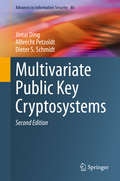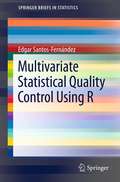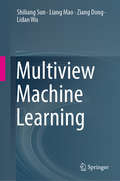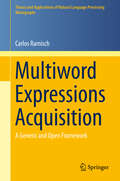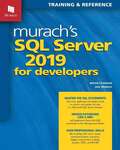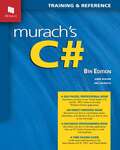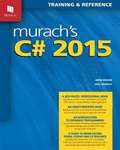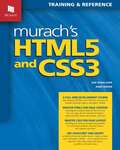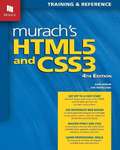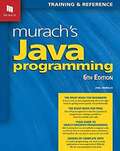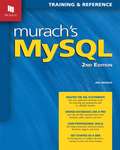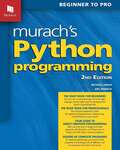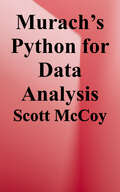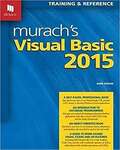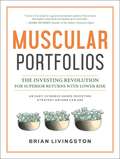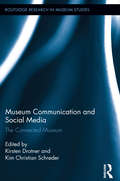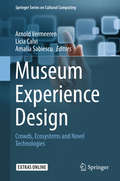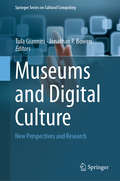- Table View
- List View
Multivariate Public Key Cryptosystems (Advances in Information Security #80)
by Jintai Ding Albrecht Petzoldt Dieter S. SchmidtThis book discusses the current research concerning public key cryptosystems. It begins with an introduction to the basic concepts of multivariate cryptography and the history of this field. The authors provide a detailed description and security analysis of the most important multivariate public key schemes, including the four multivariate signature schemes participating as second round candidates in the NIST standardization process for post-quantum cryptosystems. Furthermore, this book covers the Simple Matrix encryption scheme, which is currently the most promising multivariate public key encryption scheme. This book also covers the current state of security analysis methods for Multivariate Public Key Cryptosystems including the algorithms and theory of solving systems of multivariate polynomial equations over finite fields. Through the book’s website, interested readers can find source code to the algorithms handled in this book.In 1994, Dr. Peter Shor from Bell Laboratories proposed a quantum algorithm solving the Integer Factorization and the Discrete Logarithm problem in polynomial time, thus making all of the currently used public key cryptosystems, such as RSA and ECC insecure. Therefore, there is an urgent need for alternative public key schemes which are resistant against quantum computer attacks. Researchers worldwide, as well as companies and governmental organizations have put a tremendous effort into the development of post-quantum public key cryptosystems to meet this challenge. One of the most promising candidates for this are Multivariate Public Key Cryptosystems (MPKCs). The public key of an MPKC is a set of multivariate polynomials over a small finite field. Especially for digital signatures, numerous well-studied multivariate schemes offering very short signatures and high efficiency exist. The fact that these schemes work over small finite fields, makes them suitable not only for interconnected computer systems, but also for small devices with limited resources, which are used in ubiquitous computing.This book gives a systematic introduction into the field of Multivariate Public Key Cryptosystems (MPKC), and presents the most promising multivariate schemes for digital signatures and encryption. Although, this book was written more from a computational perspective, the authors try to provide the necessary mathematical background. Therefore, this book is suitable for a broad audience. This would include researchers working in either computer science or mathematics interested in this exciting new field, or as a secondary textbook for a course in MPKC suitable for beginning graduate students in mathematics or computer science. Information security experts in industry, computer scientists and mathematicians would also find this book valuable as a guide for understanding the basic mathematical structures necessary to implement multivariate cryptosystems for practical applications.
Multivariate Statistical Quality Control Using R
by Edgar Santos-FernándezThe intensive use of automatic data acquisition system and the use of cloud computing for process monitoring have led to an increased occurrence of industrial processes that utilize statistical process control and capability analysis. These analyses are performed almost exclusively with multivariate methodologies. The aim of this Brief is to present the most important MSQC techniques developed in R language. The book is divided into two parts. The first part contains the basic R elements, an introduction to statistical procedures, and the main aspects related to Statistical Quality Control (SQC). The second part covers the construction of multivariate control charts, the calculation of Multivariate Capability Indices.
Multiview Machine Learning
by Shiliang Sun Liang Mao Ziang Dong Lidan WuThis book provides a unique, in-depth discussion of multiview learning, one of the fastest developing branches in machine learning. Multiview Learning has been proved to have good theoretical underpinnings and great practical success. This book describes the models and algorithms of multiview learning in real data analysis. Incorporating multiple views to improve the generalization performance, multiview learning is also known as data fusion or data integration from multiple feature sets. This self-contained book is applicable for multi-modal learning research, and requires minimal prior knowledge of the basic concepts in the field. It is also a valuable reference resource for researchers working in the field of machine learning and also those in various application domains.
Multiword Expressions Acquisition
by Carlos RamischThis book is an excellent introduction to multiword expressions. It provides a unique, comprehensive and up-to-date overview of this exciting topic in computational linguistics. The first part describes the diversity and richness of multiword expressions, including many examples in several languages. These constructions are not only complex and arbitrary, but also much more frequent than one would guess, making them a real nightmare for natural language processing applications. The second part introduces a new generic framework for automatic acquisition of multiword expressions from texts. Furthermore, it describes the accompanying free software tool, the mwetoolkit, which comes in handy when looking for expressions in texts (regardless of the language). Evaluation is greatly emphasized, underlining the fact that results depend on parameters like corpus size, language, MWE type, etc. The last part contains solid experimental results and evaluates the mwetoolkit, demonstrating its usefulness for computer-assisted lexicography and machine translation. This is the first book to cover the whole pipeline of multiword expression acquisition in a single volume. It is addresses the needs of students and researchers in computational and theoretical linguistics, cognitive sciences, artificial intelligence and computer science. Its good balance between computational and linguistic views make it the perfect starting point for anyone interested in multiword expressions, language and text processing in general.
Mumboss: The Honest Mum's Guide to Surviving and Thriving at Work and at Home
by Vicki BroadbentChosen by the Independent as one of the 10 best business books written by women'Vicki is one inspirational mumboss, who shares her secrets to juggling a thriving business with raising a family in this entertaining and empowering read!' Una Healy'Ideal for going back to work without losing your mind . . . a no-nonsense guide to navigating the transition' Marie Claire 'If ever there is a person who has shown just how successful you can be online whilst also being an amazing parent it is Vicki. Read, learn and follow. A brilliant book from an inspirational mother'. Natasha Courtenay-Smith, author of The Million Dollar BlogIn Mumboss, Vicki Psarias, founder of HonestMum.com, shares her #mumboss manifesto for surviving and thriving at work and at home. Vicki writes about everything from juggling work and family, to regaining your confidence after having a baby and battling imposter syndrome.An award-winning blogger and vlogger, in this book Vicki shares how to turn your passions into a business that suits the modern mum's lifestyle. Mumboss is full of practical advice, tips and tricks to help fellow #mumbosses build their own business or return to work, while creating a personal brand and learning how to market yourself.Vicki's funny, fresh approach to life and work as a mum has brought her a loyal fanbase and a brilliantly successful business: her blog Honest Mum is one of the UK's most popular parenting and lifestyle sites, and the blog combined with Vicki's social channels has an average monthly reach of 3 million. A Lean In for the blogging and vlogging generation, Mumboss is an essential book for all parents, whether they are returning to work or looking to start a new career, as well as anyone looking to build their brand or business online.'A must-read for the modern Mum; particularly one who has aspirations to build her own business. I wish I had been able to read it three years ago!' Katie Massie-Taylor, Co-Founder, Mush
Mumboss: The Honest Mum's Guide to Surviving and Thriving at Work and at Home
by Vicki BroadbentChosen by the Independent as one of the 10 best business books written by women'Vicki is one inspirational mumboss, who shares her secrets to juggling a thriving business with raising a family in this entertaining and empowering read!' Una Healy'Ideal for going back to work without losing your mind . . . a no-nonsense guide to navigating the transition' Marie Claire 'If ever there is a person who has shown just how successful you can be online whilst also being an amazing parent it is Vicki. Read, learn and follow. A brilliant book from an inspirational mother'. Natasha Courtenay-Smith, author of The Million Dollar BlogIn Mumboss, Vicki Psarias, founder of HonestMum.com, shares her #mumboss manifesto for surviving and thriving at work and at home. Vicki writes about everything from juggling work and family, to regaining your confidence after having a baby and battling imposter syndrome.An award-winning blogger and vlogger, in this book Vicki shares how to turn your passions into a business that suits the modern mum's lifestyle. Mumboss is full of practical advice, tips and tricks to help fellow #mumbosses build their own business or return to work, while creating a personal brand and learning how to market yourself.Vicki's funny, fresh approach to life and work as a mum has brought her a loyal fanbase and a brilliantly successful business: her blog Honest Mum is one of the UK's most popular parenting and lifestyle sites, and the blog combined with Vicki's social channels has an average monthly reach of 3 million. A Lean In for the blogging and vlogging generation, Mumboss is an essential book for all parents, whether they are returning to work or looking to start a new career, as well as anyone looking to build their brand or business online.'A must-read for the modern Mum; particularly one who has aspirations to build her own business. I wish I had been able to read it three years ago!' Katie Massie-Taylor, Co-Founder, Mush
Mumboss: The Honest Mum's Guide to Surviving and Thriving at Work and at Home
by Vicki PsariasChosen by the Independent as one of the 10 best business books written by women'Vicki is one inspirational mumboss, who shares her secrets to juggling a thriving business with raising a family in this entertaining and empowering read!' Una Healy'Ideal for going back to work without losing your mind . . . a no-nonsense guide to navigating the transition' Marie Claire 'If ever there is a person who has shown just how successful you can be online whilst also being an amazing parent it is Vicki. Read, learn and follow. A brilliant book from an inspirational mother'. Natasha Courtenay-Smith, author of The Million Dollar BlogIn Mumboss, Vicki Psarias, founder of HonestMum.com, shares her #mumboss manifesto for surviving and thriving at work and at home. Vicki writes about everything from juggling work and family, to regaining your confidence after having a baby and battling imposter syndrome.An award-winning blogger and vlogger, in this book Vicki shares how to turn your passions into a business that suits the modern mum's lifestyle. Mumboss is full of practical advice, tips and tricks to help fellow #mumbosses build their own business or return to work, while creating a personal brand and learning how to market yourself.Vicki's funny, fresh approach to life and work as a mum has brought her a loyal fanbase and a brilliantly successful business: her blog Honest Mum is one of the UK's most popular parenting and lifestyle sites, and the blog combined with Vicki's social channels has an average monthly reach of 3 million. A Lean In for the blogging and vlogging generation, Mumboss is an essential book for all parents, whether they are returning to work or looking to start a new career, as well as anyone looking to build their brand or business online.'A must-read for the modern Mum; particularly one who has aspirations to build her own business. I wish I had been able to read it three years ago!' Katie Massie-Taylor, Co-Founder, Mush
Mundania: How and Where Technologies Are Made Ordinary
by Robert WillimDigital services, platforms and arrangements are often promoted as smooth and convenient, smart or intelligent. When introduced, devices can appear utterly fascinating or awkward, even disquieting. Eventually, however, they soon disappear in the muddle of everyday life. This is how Mundania takes form. Based on original research, this book uses the concept of mundania to better understand technological change. Scholar-artist Robert Willim deftly unpacks the interplay between everyday life and the immense complexity of technological infrastructures. Offering imaginative new insights into our relationship with technology, this book will appeal to readers in a range of fields from science and technology studies and media studies to the arts.
Murach's Sql Server 2019 For Developers
by Joel Murach Bryan SyversonIf you're an application developer, or you're training to be one, this latest edition of Murach's classic SQL Server book is made for you. To start, it presents the SQL statements that you need to retrieve and update the data in a database. These are the SQL statements that you'll use every day. Then, it shows you how to design a database, how to implement that design, and how to work with database features like views, scripts, stored procedures, functions, triggers, transactions, security, XML data, and BLOB data with FILESTREAM storage. The result? You'll be able to create database applications that are thoroughly professional. You'll be familiar with the DBA-related issues that let you work far more effectively than most of your colleagues. And you'll have a handy reference at your side to answer questions and handle new challenges as they come up.
Murach's C#
by Anne Boehm Joel Murach Anne BoehmnThis C# book has been a favorite of developers ever since the 1st edition came out in 2004. So you can be sure that this latest edition will deliver the professional skills you're looking for today. In fact, it will teach you the C# essentials more easily than ever, as it shows you how to take advantage of the most recent releases of C#, .NET, and Visual Studio.
Murach's C#
by Anne Boehm Joel MurachThe 8th Edition of Murach’s C# does a better job than ever of teaching the C# programming language. Each section features clear examples and easy-to-understand explanations that walk you through crucial skills, best practices, and helpful tips.
Murach's C# 2015
by Anne Boehm Joel MurachMicrosoft's Visual C# is an elegant, object-oriented language that uses syntax that's similar to C++ and Java. This 2015 edition has been updated throughout to make it easier for you to gain the C# and Visual Studio skills that employers are looking for in today's application developers. This book is for anyone who wants to learn how to use Visual C# 2015 for developing professional Windows Forms applications using Visual Studio 2015 and the .NET Framework. That includes the entire range of developers from complete beginners to experienced Java, C++, and Visual Basic programmers.
Murach's HTML5 and CSS3
by Zak Ruvalcaba Anne BoehmHTML5 and CSS3 (the latest standards for HTML and cascading style sheets) are packed with coding options that make it easier than ever to create web pages with the features users want today, from an up-to-date look and feel. . . to immediate validation of user entries . . . to audio and video samplings. At the same time, there are still older browsers and millions of existing web sites that require you to integrate HTML5 and CSS3 features with the earlier standards. So how do you learn all this? This book is exactly the practical approach you need. It teaches you how to use HTML5 and CSS3 the way they were meant to work, with HTML5 to provide the page content and CSS3 to format the content and lay out the pages. But it also teaches you how to use the HTML5 and CSS3 features alongside the earlier standards to ensure that your pages will work for the widest possible audience. So if you are going to be developing web pages. . . whether you are a web designer, a JavaScript programmer, a server-side programmer, or a rookie . . . this book is for you.
Murach's Html5 And Css3
by Zak Ruvalcaba Anne Boehm<P><P>"Until now, my websites looked great but have been coded with what seems like 'duct-tape and bubble-gum' methods, just for appearances and not for professionalism or compliance. This book taught me all that is possible with HTML and CSS coding]]. What a game changer!" That's what one web designer posted about a previous edition of Murach's HTML5 and CSS3. Now, this 4th Edition updates and improves all the HTML and CSS content in the book...and it adds coverage of Flexible Box and Grid Layout, two new CSS3 ways to implement page layouts. So whether you're a web designer, a JavaScript programmer, a server-side programmer, or a rookie, this book delivers all the HTML and CSS skills that you need on the job. <P><P> This book begins with an 8-chapter hands-on course that teaches you HTML and CSS from scratch, including the latest HTML5 and CSS3 features. This short course ends with a chapter that teaches you how to use fluid design and media queries to implement Responsive Web Design so your pages will look good and work right on any screen, from phone to tablet to desktop. <P><P> After that, the unique design of this book lets you go on to any other chapter to learn new skills whenever you need them. For example, chapters 9 and 10 show you how to use Flexible Box and Grid Layout. Chapter 13 shows you how to work with forms and data validation. Chapter 14 shows you how to enhance a site with video clips. Chapter 16 shows you how to use CSS3 transitions, transforms, and animations. Chapters 17 and 18 show you how to design and deploy a website. Chapters 19 and 20 introduce other professional skills like how to use JavaScript and jQuery and how to use development tools like Bootstrap, SASS, and Emmet. And after you've learned all the skills that you need, this book becomes the best on-the-job reference you've ever used.
Murach's Java Programming
by Joel MurachIf you want to learn Java programming but don’t know where to start, this is the right book for you. From the first page, our unique self-paced approach will help you build competence and confidence in your programming skills, even if you’re completely new to programming. But this isn’t just a book for beginners! Our self-paced approach also works for experienced programmers, helping you learn Java faster and better than you’ve ever learned a language before. By the time you’re through, you will have mastered all of the Java skills that are needed on the job, including the skills for developing object-oriented applications that use a graphical user interface (GUI) and a database. To make this possible, section 1 of this book presents a 9-chapter course that gets anyone off to a great start building object-oriented applications in Java. Then, the next 3 sections build on that base by presenting more on object-oriented programming, the essentials for developing GUIs, and additional skills that every professional Java programmer should have, including how to work with a database.
Murach's Java Servlets and JSP
by Michael Urban Joel MurachThis new edition of Murach's Java Servlets and JSP makes it easier than ever for Java developers to master web programming. It shows how to install and use the Tomcat server and the NetBeans IDE. It shows how to use JSPs and servlets to build secure and well-structured web applications that implement the MVC pattern. It shows how to use sessions, cookies, JavaBeans, EL, JSTL, and custom tags. It shows how to use JDBC or JPA to work with a MySQL database. It shows how to work with JavaMail, SSL connections, authentication, encryption, filters, and listeners. It even includes an introduction to JSF to expand your perspective on Java web programming. These are the skills that you need to build professional Java web applications using servlets and JSP. A great read for any Java developer.
Murach's MySQL
by Joel Murach<p>Now, this 2nd Edition has been updated and improved throughout. As a result, it's easier than ever to use for learning MySQL from scratch, for switching to MySQL from another flavor of SQL (like MS SQL Server or Oracle), or for quickly looking up the forgotten details that are so essential as you develop database applications. <p>Section 1 introduces you to relational databases and SQL, shows you how to use the graphical MySQL Workbench to work with a MySQL database, and teaches you to code SQL queries to retrieve, add, update, and delete data in a MySQL database. Section 2 goes deeper into querying, showing you how to work with summary queries, subqueries, data types, and functions. Section 3 shows you how to design a MySQL database using an EER model, implement the design, and create views. Section 4 shows how to create stored procedures that provide functionality similar to procedural programming languages like PHP, Java, C++, C#, and VB. And Section 5 introduces you to database administration tasks like securing and backing up database data. <p>Whether you start from the beginning or jump in anywhere, it's a great guide for MySQL users at any level.</p>
Murach's Python Programming
by Michael Urban Joel MurachIf you want to learn how to program but don't know where to start, this is the right book and the right language for you. From the first page, our self-paced approach will help you build competence and confidence in your programming skills. And Python is the best language ever for learning how to program because of its simplicity and breadth…two features that are hard to find in a single language. But this isn't just a book for beginners! Our self-paced approach also works for experienced programmers, helping you learn Python faster and better than you've ever learned a language before. By the time you're through, you will have mastered the key Python skills that are needed on the job, including those for object-oriented, database, and GUI programming. To make all of this possible, section 1 presents an 8-chapter course that will get anyone off to a great start with Python. Section 2 builds on that base by presenting the other essential skills that every Python programmer should have. Section 3 shows you how to develop object-oriented programs, a critical skillset in today's world. And section 4 shows you how to apply all of the skills that you've already learned as you build database and GUI programs for the real world.
Murach's Python for Data Analysis
by Scott McCoyData is collected everywhere these days, in massive quantities. But data alone does not do you much good. That is why data analysis -- making sense of the data -- has become a must-have skill in the fields of business, science, and social science. But it is a tough skill to acquire. The concepts are challenging, and too many books and online tutorials treat only parts of the total skillset needed. <p><p>Now, though, this book draws all the essential skills together and presents them in a clear and example-packed way. So you will soon be applying your programming skills to complex data analysis problems, more easily than you ever thought possible. In terms of content, this book gets you started the right way by using Pandas for data analysis and Seaborn for data visualisation, with JupyterLab as your IDE. Then, it helps you master descriptive analysis by teaching you how to get, clean, prepare, and analyse data, including time-series data. Next, it gets you started with predictive analysis by showing you how to use linear regression models to predict unknown and future values. And to tie everything together, it gives you 4 real-world case studies that show you how to apply your new skills to political, environmental, social, and sports analysis. <p><p>At the end, you will have a solid set of the professional skills that can lead to all sorts of new career opportunities. Sound too good to be true? Download a sample chapter for free from the Murach website and see for yourself how this book can turn you into the data analyst that companies are looking for.
Murach's SQL Server 2016 For Developers
by Joel Murach Bryan SyversonIf you want to learn SQL, you've picked the right book. And if you want to learn the specifics of SQL for SQL Server 2016, you've made an especially good choice. Along the way, you'll learn a lot about relational database management systems in general and about SQL Server in particular. Why learn SQL? First, because most programmers would be better at database programming if they knew more about SQL. Second, because SQL programming is a valuable specialty in itself. And third, because knowing SQL is the first step toward becoming a database administrator. In short, knowing SQL makes you more valuable on the job.
Murach's Visual Basic 2015
by Anne BoehmThis core Visual Basic .NET book has been a favorite of developers ever since the 1st edition came out in 2002. So you can be sure that this 6th edition will deliver the professional skills you're looking for. <p><p>To be specific:<p> It's a self-paced book that shows you how to use Visual Studio 2015, VB 2015, and the .NET 4.6 classes to develop Windows Forms applications...whether you're new to programming or not.<p> It's a data programming book that shows you how to create professional database applications using data sources, ADO.NET code, and the Entity Framework, as well as how to use LINQ to query data structures, from collections to arrays to datasets.<p> It's an object-oriented book that shows you how to use business classes, inheritance, and interfaces the way they're used in the real world.<p> When you're done, you'll be able to develop 3-tiered, object-oriented Windows Forms applications the way the best professionals do. <p>And you'll have the core VB and Visual Studio skills that you need to develop any VB application...whether for Windows, the web, or mobile devices.
Muscular Portfolios: The Investing Revolution for Superior Returns with Lower Risk
by Brian LivingstonMuscular Portfolios is here to change the investing game — and help you leave stress behind with a stronger, smarter approach to investing. For decades, the financial services industry has sold risky investments, claiming that this was the only path to large gains. But this strategy is highly vulnerable to big losses that can devastate your portfolio. Today, there's a better approach. It combines the latest academic research in finance with the new ultra-low-cost index funds (exchange-traded funds). The result is an approach that provides market-like returns with dramatically smaller losses and requires only 15 minutes a month or less. Muscular Portfolios lays out the basic principles of this kind of investing so you can manage your own money successfully — without turning it into your second job. Investigative journalist Brian Livingston takes you behind the curtain of Wall Street and lays out a game-changing approach to investing: Muscular Portfolios, which are easy-to-use financial strategies you can set up yourself, even if you have no investment experience at all. Filled with helpful illustrations, compelling evidence, and simple, no-nonsense instructions, Muscular Portfolios is a resource, not a sales pitch. There are no financial products to buy, no secret formula to pay for. Everything is fully disclosed in bite-sized steps — and on a totally free website — that you can start using today to grow your wealth. Driven by cutting-edge investment research and backed by extensive market testing, Muscular Portfolios will revolutionize investing for families and individual investors.
Museum Communication and Social Media: The Connected Museum (Routledge Research in Museum Studies #6)
by Kirsten Drotner Kim Christian SchrøderVisitor engagement and learning, outreach, and inclusion are concepts that have long dominated professional museum discourses. The recent rapid uptake of various forms of social media in many parts of the world, however, calls for a reformulation of familiar opportunities and obstacles in museum debates and practices. Young people, as both early adopters of digital forms of communication and latecomers to museums, increasingly figure as a key target group for many museums. This volume presents and discusses the most advanced research on the multiple ways in which social media operates to transform museum communications in countries as diverse as Australia, Denmark, Germany, Norway, the UK, and the United States. It examines the socio-cultural contexts, organizational and education consequences, and methodological implications of these transformations.
Museum Experience Design
by Arnold Vermeeren Licia Calvi Amalia SabiescuThis state-of-the-art book explores the implications of contemporary trends that are shaping the future of museum experiences. In four separate sections, it looks into how museums are developing dialogical relationships with their audiences, reaching out beyond their local communities to involve more diverse and broader audiences. It examines current practices in involving crowds, not as passive audiences but as active users, co-designers and co-creators; it looks critically and reflectively at the design implications raised by the application of novel technologies, and by museums becoming parts of connected museum systems and large institutional ecosystems. Overall, the book chapters deal with aspects such as sociality, creation and sharing as ways of enhancing dialogical engagement with museum collections. They address designing experiences – including participatory exhibits, crowd sourcing and crowd mining – that are meaningful and rewarding for all categories of audiences involved. Museum Experience Design reflects on different approaches to designing with novel technologies and discusses illustrative and diverse roles of technology, both in the design process as well as in the experiences designed through those processes. The trend of museums becoming embedded in ecosystems of organisations and people is dealt with in chapters that theoretically reflect on what it means to design for ecosystems, illustrated by design cases that exemplify practical and methodological issues in doing so. Written by an interdisciplinary group of design researchers, this book is an invaluable source of inspiration for researchers, students and professionals working in this dynamic field of designing experiences for and around museums.
Museums and Digital Culture: New Perspectives and Research (Springer Series on Cultural Computing)
by Jonathan P. Bowen Tula GianniniThis book explores how digital culture is transforming museums in the 21st century. Offering a corpus of new evidence for readers to explore, the authors trace the digital evolution of the museum and that of their audiences, now fully immersed in digital life, from the Internet to home and work. In a world where life in code and digits has redefined human information behavior and dominates daily activity and communication, ubiquitous use of digital tools and technology is radically changing the social contexts and purposes of museum exhibitions and collections, the work of museum professionals and the expectations of visitors, real and virtual. Moving beyond their walls, with local and global communities, museums are evolving into highly dynamic, socially aware and relevant institutions as their connections to the global digital ecosystem are strengthened. As they adopt a visitor-centered model and design visitor experiences, their priorities shift to engage audiences, convey digital collections, and tell stories through exhibitions. This is all part of crafting a dynamic and innovative museum identity of the future, made whole by seamless integration with digital culture, digital thinking, aesthetics, seeing and hearing, where visitors are welcomed participants. The international and interdisciplinary chapter contributors include digital artists, academics, and museum professionals. In themed parts the chapters present varied evidence-based research and case studies on museum theory, philosophy, collections, exhibitions, libraries, digital art and digital future, to bring new insights and perspectives, designed to inspire readers. Enjoy the journey!
